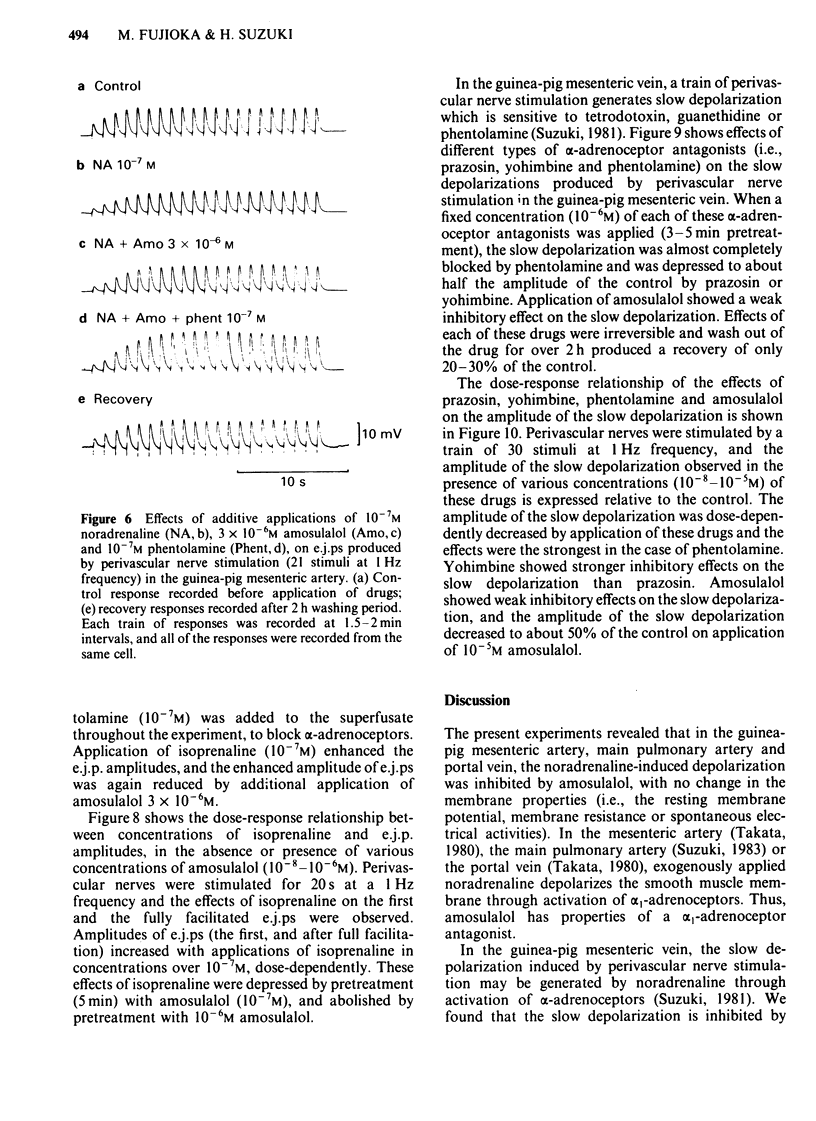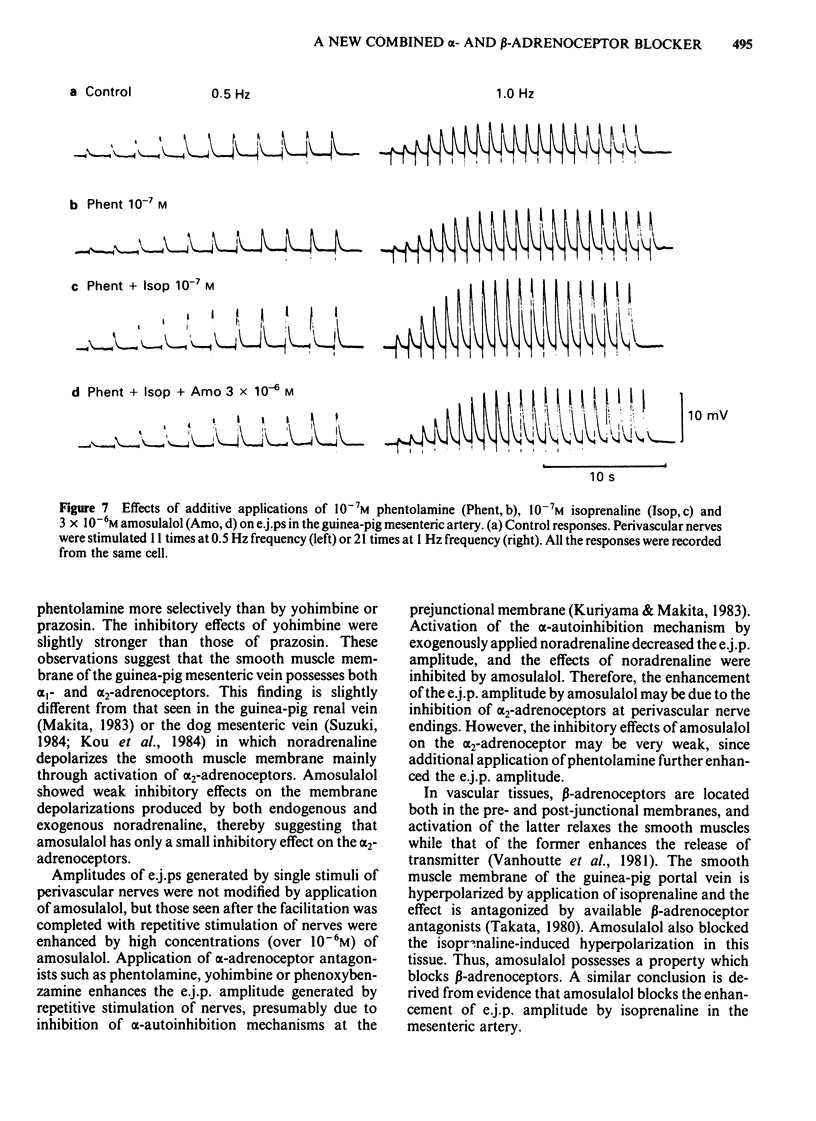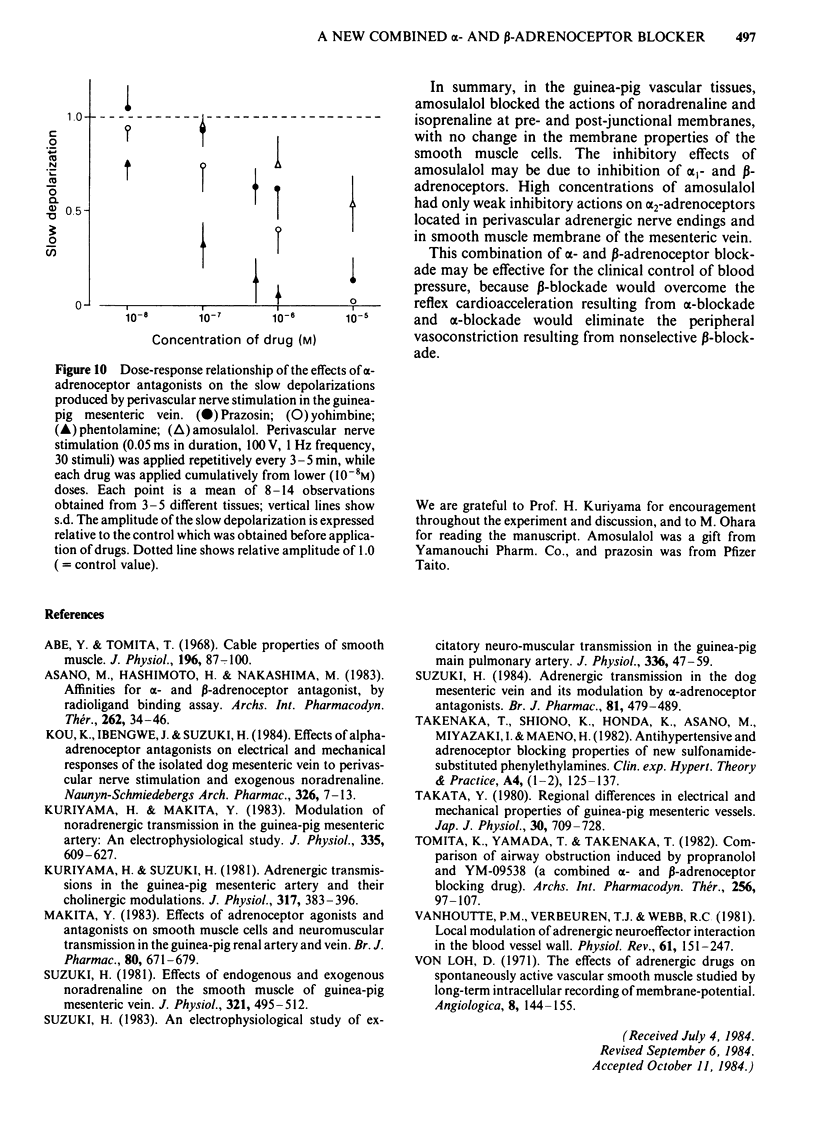Abstract
The effects of amosulalol, a newly synthesized sulphonamide-substituted phenylethylamine derivative, on electrical responses of smooth muscle cells of the guinea-pig vascular tissues to noradrenaline, isoprenaline and perivascular nerve stimulation were investigated. Amosulalol (10(-10) -10(-5)M) did not alter the resting membrane potential of smooth muscle cells of the mesenteric artery, the mesenteric vein, the main pulmonary artery and the portal vein. In the mesenteric artery, main pulmonary artery and portal vein, but not in the mesenteric vein, membrane depolarizations produced by noradrenaline were antagonized by amosulalol. In the portal vein, membrane hyperpolarizations produced by isoprenaline were antagonized by amosulalol. In the mesenteric artery, amosulalol (over 10(-6)M) enhanced the amplitude of excitatory junction potentials (e.j.ps) produced by perivascular nerve stimulation. Amosulalol antagonized the noradrenaline-induced decrease in the e.j.p. amplitude; this effect was much weaker than that of phentolamine. Amosulalol also antagonized the isoprenaline-induced enhancement of the e.j.p. amplitude. In the mesenteric vein, the slow depolarizations produced by perivascular nerve stimulation were depressed by amosulalol (over 10(-6)M), but the effect was much weaker than that of prazosin, yohimbine or phentolamine. Actions of amosulalol on electrical properties of vascular tissues can be summarized as follows: amosulalol blocks alpha 1- and beta-adrenoceptors. It also blocks alpha 2-adrenoceptors, though weakly.
Full text
PDF








Selected References
These references are in PubMed. This may not be the complete list of references from this article.
- Abe Y., Tomita T. Cable properties of smooth muscle. J Physiol. 1968 May;196(1):87–100. doi: 10.1113/jphysiol.1968.sp008496. [DOI] [PMC free article] [PubMed] [Google Scholar]
- Asano M., Hashimoto H., Nakashima M. Affinities for alpha- and beta-adrenoceptor subtypes of YM-09538, a new combined alpha- and beta-adrenoceptor antagonist, by radioligand binding assay. Arch Int Pharmacodyn Ther. 1983 Mar;262(1):34–46. [PubMed] [Google Scholar]
- Kou K., Ibengwe J., Suzuki H. Effects of alpha-adrenoceptor antagonists on electrical and mechanical responses of the isolated dog mesenteric vein to perivascular nerve stimulation and exogenous noradrenaline. Naunyn Schmiedebergs Arch Pharmacol. 1984 May;326(1):7–13. doi: 10.1007/BF00518772. [DOI] [PubMed] [Google Scholar]
- Kuriyama H., Makita Y. Modulation of noradrenergic transmission in the guinea-pig mesenteric artery: an electrophysiological study. J Physiol. 1983 Feb;335:609–627. doi: 10.1113/jphysiol.1983.sp014554. [DOI] [PMC free article] [PubMed] [Google Scholar]
- Kuriyama H., Suzuki H. Adrenergic transmissions in the guinea-pig mesenteric artery and their cholinergic modulations. J Physiol. 1981 Aug;317:383–396. doi: 10.1113/jphysiol.1981.sp013831. [DOI] [PMC free article] [PubMed] [Google Scholar]
- Makita Y. Effects of adrenoceptor agonists and antagonists on smooth muscle cells and neuromuscular transmission in the guinea-pig renal artery and vein. Br J Pharmacol. 1983 Dec;80(4):671–679. doi: 10.1111/j.1476-5381.1983.tb10057.x. [DOI] [PMC free article] [PubMed] [Google Scholar]
- Suzuki H. Adrenergic transmission in the dog mesenteric vein and its modulation by alpha-adrenoceptor antagonists. Br J Pharmacol. 1984 Mar;81(3):479–489. doi: 10.1111/j.1476-5381.1984.tb10101.x. [DOI] [PMC free article] [PubMed] [Google Scholar]
- Suzuki H. An electrophysiological study of excitatory neuromuscular transmission in the guinea-pig main pulmonary artery. J Physiol. 1983 Mar;336:47–59. doi: 10.1113/jphysiol.1983.sp014565. [DOI] [PMC free article] [PubMed] [Google Scholar]
- Suzuki H. Effects of endogenous and exogenous noradrenaline on the smooth muscle of guinea-pig mesenteric vein. J Physiol. 1981 Dec;321:495–512. doi: 10.1113/jphysiol.1981.sp013999. [DOI] [PMC free article] [PubMed] [Google Scholar]
- Takata Y. Regional differences in electrical and mechanical properties of guinea-pig mesenteric vessels. Jpn J Physiol. 1980;30(5):709–728. doi: 10.2170/jjphysiol.30.709. [DOI] [PubMed] [Google Scholar]
- Takenaka T., Shiono K., Honda K., Asano M., Miyazaki I., Maeno H. Antihypertensive and adrenoceptor blocking properties of new sulfonamide-substituted phenylethylamines. Clin Exp Hypertens A. 1982;4(1-2):125–137. doi: 10.3109/10641968209061580. [DOI] [PubMed] [Google Scholar]
- Tomioka K., Yamada T., Takenaka T. Comparison of airway obstruction induced by propranolol and YM-09538 (a combined alpha- and beta-adrenoceptor blocking drug). Arch Int Pharmacodyn Ther. 1982 Mar;256(1):97–107. [PubMed] [Google Scholar]
- Vanhoutte P. M., Verbeuren T. J., Webb R. C. Local modulation of adrenergic neuroeffector interaction in the blood vessel well. Physiol Rev. 1981 Jan;61(1):151–247. doi: 10.1152/physrev.1981.61.1.151. [DOI] [PubMed] [Google Scholar]
- von Loh D. The effect of adrenergic drugs on spontaneously active vascular smooth muscle studied by long-term intracellular recording of membrane-potential. Angiologica. 1971;8(3-5):144–155. doi: 10.1159/000157889. [DOI] [PubMed] [Google Scholar]


